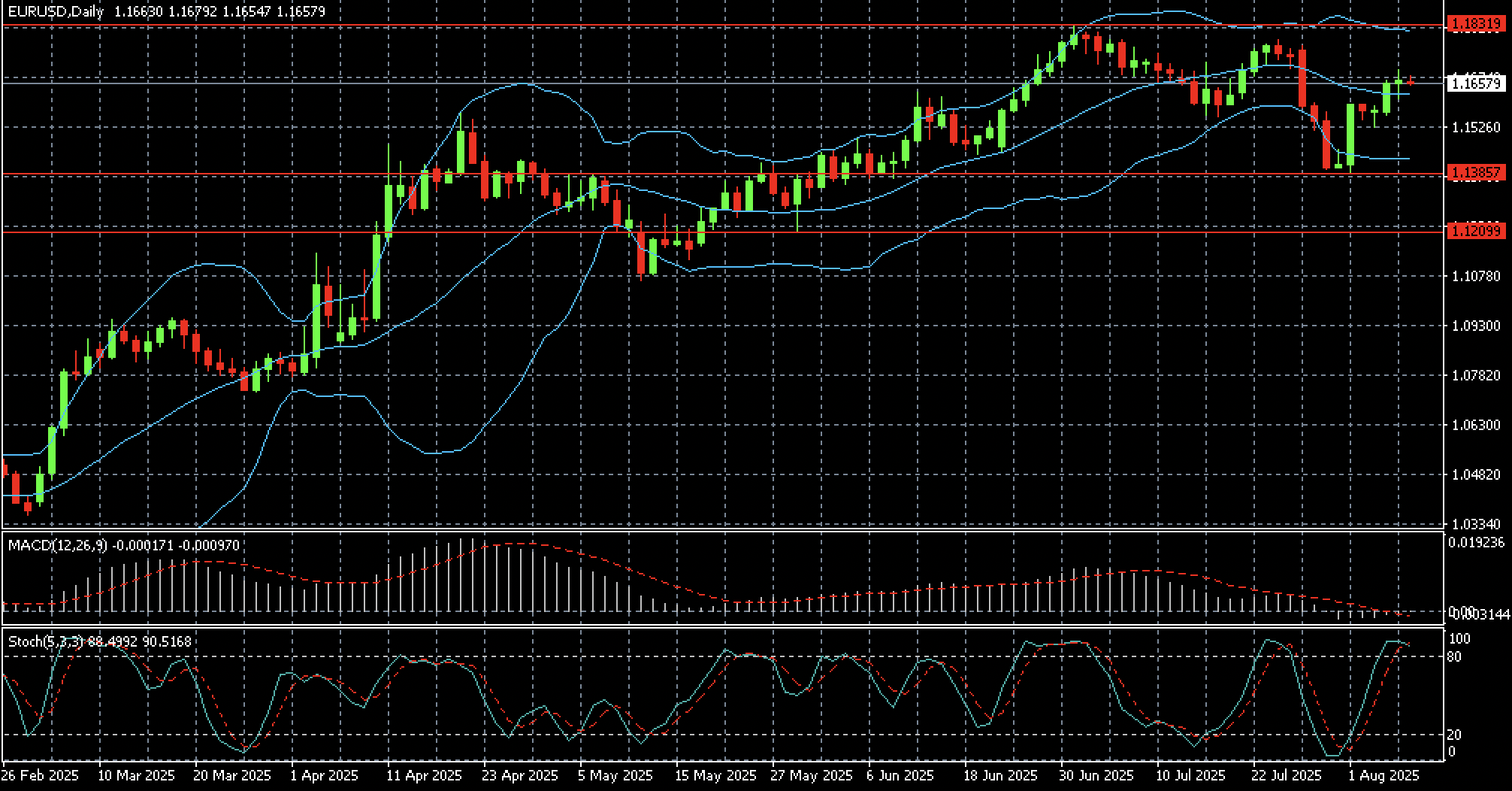EURUSD weekly forecast: euro has more strength than the US dollar
Expectations of a Fed rate cut by the end of the year remain after weak US labour market data, which limits the dollar’s potential. At the same time, macroeconomic statistics from the eurozone remain weak, with GDP up only 0.1%, and business activity under pressure. However, the decline in US Treasury yields and profit-taking on the USD allow the pair to hold above 1.1650.
The overall picture in EURUSD is still determined by the balance of monetary policy expectations and external trade risks. If the Fed continues to signal its readiness to ease policy, the euro may maintain its recovery.
In this article, we analyse what to expect for the EURUSD pair in the new week of August.
EURUSD forecast for this week: quick overview
- Market focus:
The EURUSD pair is hovering near monthly highs amid dollar weakness and moderate recovery in risk appetite. Pressure on the USD came from weak US labour market data as initial jobless claims exceeded expectations, while the total number of continuing claims hit a three-year high.
Additional pressure came from political uncertainty: Donald Trump confirmed changes to the Federal Reserve Board and is considering replacing current chairman Jerome Powell. These signals boosted expectations of a rate cut as early as September.
In the eurozone, economic statistics remain weak, but the euro received short-term support amid the general weakening of the US dollar and persistent divergence in monetary policy expectations.
- Current trend:
The EURUSD pair ended the week higher, around 1.1670, hitting a two-week high. The pair consolidated above the key 1.1550 level and remains in a medium-term upward channel. While MACD and the Stochastic Oscillator confirm the positive momentum, they are both in overbought territory, which may indicate a short-term correction.
The drivers of growth remain dollar weakness and expectations of Fed policy easing.
- EUR/USD forecast for 11-15 August 2025:
The baseline scenario suggests a movement in the 1.1550-1.1730 range with attempts to test the upper boundary if dollar pressure persists. Steady growth is possible in the case of weak inflation and retail sales data from the US.
The downside scenario will activate if the pair drops below 1.1550; then it may return to 1.1380.
EURUSD fundamental analysis
The EURUSD pair ended the week higher at two-week highs. The euro was supported by weak US macroeconomic data and rising expectations of a Federal Reserve rate cut in September. The dollar index fell below 98 points, posting a weekly decline of 0.5%.
The key factor of the week was the US labour market data. Initial jobless claims totalled 226 thousand, above the forecast of 221 thousand, and continuing claims reached 1.974 million, the highest since 2021. This strengthened expectations of monetary policy easing, with markets pricing in more than a 90% chance of a rate cut this autumn.
Additional impact on the dollar came from the political agenda. President Donald Trump nominated Stephen Miran to the Federal Reserve Board of Governors and is also considering Christopher Waller for the post of Fed chair. This increased expectations of a softer policy line in the future.
The market is still watching the development of US trade policy. Broad tariffs ranging from 10% to 50% on goods from dozens of countries came into effect during the week. Particularly tough measures hit semiconductors and Indian imports. The threat of new duties on China adds tension to global markets and affects dollar dynamics.
The overall sentiment remains moderately positive for the euro amid dollar weakness and rising political uncertainty in the US. The market is focused on upcoming inflation data and new signals from the Fed.
EURUSD technical analysis
On the daily timeframe, the EURUSD pair has continued to trade in an uptrend since March 2025. The chart shows a consolidation phase in June and July, followed by a recovery in early August.
The pair is holding in the upper part of the Bollinger channel, confirming the bullish momentum. However, the Stochastic has entered the overbought zone (above 90), which may indicate a short-term slowdown in growth or a pullback.
The MACD indicator remains near zero, reflecting weak momentum dynamics and a possible transition to sideways movement.
The nearest resistance level is at 1.1830, the late June high. The support level is located at 1.1385, with the key level at 1.1210. A breakout above 1.1700 will open the way to new highs, while a move below 1.1550 will increase correction risks.
EURUSD trading scenarios
The outlook for the EURUSD pair for the new week is neutral to positive.
Pressure on the US dollar increased after weak jobless claims data and rising expectations of a Federal Reserve rate cut as early as September. The appointment of Stephen Miran to the Board of Governors and discussions of Christopher Waller as a possible Fed chair intensified political uncertainty.
Against this backdrop, the euro strengthened despite sluggish eurozone economic indicators. The positive sentiment for EUR/USD remains, but in overbought market conditions, a local correction is possible.
- Buy scenario (long):
Buying is justified if the pair holds above 1.1620-1.1650. This will be confirmed by consolidation near weekly highs and stabilisation in the US labour market.
Targets are 1.1730 and, with favourable fundamentals, 1.1830.
Stop-loss is below 1.1580: a breakout below this area would strengthen sellers’ pressure.
- Sell scenario (short):
Short-term selling is possible if the pair returns below 1.1580 amid profit-taking and weak European data. The MACD and Stochastic indicators signal overbought conditions.
Targets are 1.1500 and 1.1385 if the downward momentum strengthens.
Stop-loss is above 1.1675: a move beyond this level would confirm the continuation of the uptrend.
Summary
Positive sentiment in the EURUSD pair is supported by signs of a cooling US economy and rising expectations of a Fed rate cut towards the end of the year. An additional boost came from profit-taking on the dollar and easing fears over trade policy. In Europe, the picture remains mixed, but the euro is stable: weak GDP growth is offset by stabilising inflation expectations and moderate optimism over trade talks.
Overall sentiment is cautiously positive. The market awaits new drivers: key events include US inflation reports and comments from Fed officials. If tensions on the trade front do not escalate, the euro may continue to rise.



